a warning about cleaning fossilized megalodon teeth with vinegar
Will soaking my fossilized megalodon tooth in vinegar make it easy to clean?
Will vinegar damage my megalodon tooth?
After being asked about the use of acids to clean megalodon teeth and other fossilized shark teeth I decided to write an article about some of the dangers of cleaning fossilized shark teeth with vinegar.
I personally don't like to use vinegar to clean the megalodon teeth for sale I have in my online store or the ones in my personal collection.
Using vinegar to clean shark teeth, specifically fossilized megalodon teeth is a somewhat common practice. The problem is that most people do not understand the damage they are doing to their fossilized shark teeth when they leave them to soak in vinegar or other acids.
doing to their fossilized shark teeth when they leave them to soak in vinegar or other acids.
In this article I will try to explain and demonstrate through pictures the downside of cleaning a tooth with vinegar, apple cider vinegar, or other chemicals.
Many times when fossilized megalodon teeth are found they are dirty, they have sand, clay, mud, or some other kind of sediment on them that can be simply rinsed or lightly brushed off. However, most megalodon and other sharks teeth found in coastal rivers and streams along with the ocean have growth attached to them that many people want to clean. Since that growth is often oysters, barnacles, coral, or other difficult small animal or plant life it can be very difficult to mechanically clean those teeth. Because of the difficulty of mechanically cleaning those megalodon teeth people will sometimes turn to chemicals and acids such as vinegar.
The logic behind using white vinegar, apple cider vinegar, or other acids is that they soften and break down the calcium growths that are on many fossilized megalodon shark teeth. If the calcium based oyster shells, barnacles, and corals are softened or dissolved the tooth cleaning process becomes much easier. The problem however is that the acid in those solutions also can affect the tooth, enamel, bourlette, and root. So what seems like an easy solution to cleaning the tooth can actually lighten, bleach, and significantly alter the fossilized shark tooth.
I get asked all the time "What is the best way to clean shark teeth?" and my response is usually "Very carefully". Because megalodon shark teeth are found in a wide variety of environments, have been fossilized in many different mineral compositions, have been exposed in a myriad of different conditions, and have all kinds of different growth on them there is no catch-all solution to how to clean shark teeth. Most shark teeth can be mechanically cleaned however it is very time consuming and if you slip you may damage the tooth. Because of the time required to properly clean a tooth without chemicals many tooth sellers will simply soak their teeth in an acid solution for a long period of time to make cleaning easier, and because the buyer did not see the original tooth color they may not realize the tooth was significantly lightened during the cleaning process.
I answer the "vinegar" questions fairly often so I decided to do a simple experiment with some fossilized megalodon teeth, some vinegar, and a camera. Because seeing is believing and a picture says a thousand words, so here are a few thousand words worth of pictures why it is not a good idea to haphazardly throw your megalodon shark teeth in vinegar or other acids.
I started with four megalodon teeth, well four half megalodon teeth to be exact. I chose half teeth because I knew that by conducting this experiment I might unevenly lighten the teeth and could not stand to do that to a complete 4-5" megalodon tooth. (See Below)


For this experiment I used the two most commonly recommended solutions for cleaning megalodon and other fossilized shark teeth. White and Apple Cider vinegar. Many people suggest that there is a risk of tooth bleaching with vinegar and you should use a diluted solution so to cover that base I used the following solutions.
- White Vinegar 100%
- Apple Cider Vinegar 100%
- White Vinegar and Water 50/50 Ratio
- Apple Cider Vinegar and Water 50/50 Ratio
I then put the four half megalodon teeth into their respective vinegar solutions, I only put the teeth in half way so if bleaching/lightening occurred it would be obvious without looking at before and after pictures. When cleaning teeth some people will soak the entire tooth for prolonged periods of time which lightens the entire tooth, making it more difficult to tell the tooth was bleached in the first place, but more on that later.
I then let the teeth soak for 30 minutes, I chose 30 minutes because in most of the cleaning guides I have read most people suggest soaking teeth in a vinegar solution for 20-40 minutes and I made the assumption that if any bleaching occurred in 30 minutes one could deduce that significant lightening would occur if teeth were left to soak overnight or for a few days. So I took the four half megalodon teeth and soaked them in the various solutions listed above for 30 minutes.(See Below)

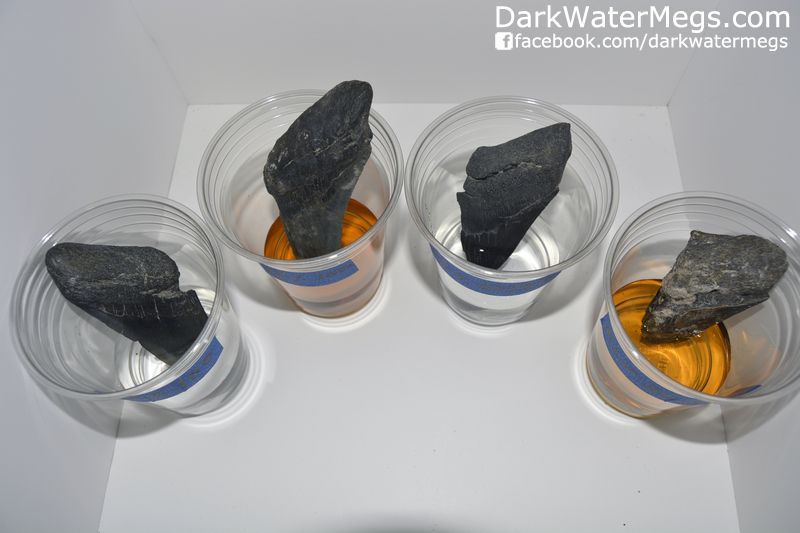
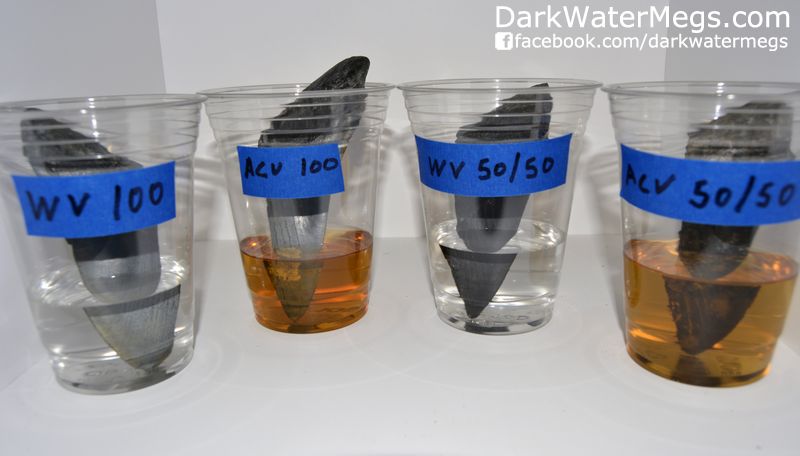
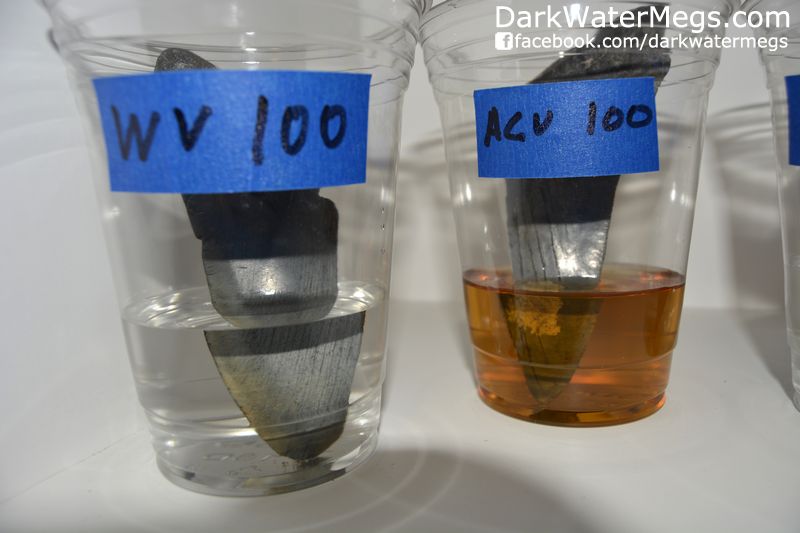

After 30 minutes I pulled the teeth out and took the picture below before soaking the teeth in water overnight. I soaked the teeth in water for about 10 hours to make sure all of the vinegar was rinsed from the tooth. (See Below)

At this point in the process the tooth that had been soaked in the White Vinegar 100% solution showed signs of lightening and less obvious but still present was some bleaching on the tooth in the White Vinegar and Water 50/50 Ratio. The two teeth that had been soaked in 100% and 50/50 Apple Cider Vinegar at this point looked like they had made it through the soaking process relatively well and without any noticeable lightening. (See Below)
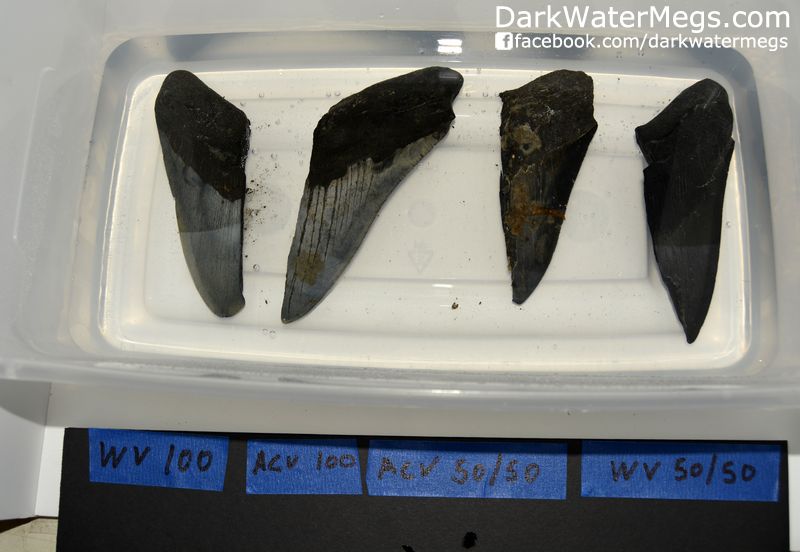
The next day I mechanically cleaned all four of the teeth, rinsed any sand from them and took yet another picture. Like the previous day after the teeth appeared about the same, the two soaked in the White Vinegar solutions had varying degrees of bleaching and the two soaked in the Apple Cider Vinegar solutions looked less damaged. I will note that when I was mechanically cleaning all four of the teeth with micropics and brushes the portions of the teeth that had been soaked in vinegar were easier to clean, which is why many people choose to soak teeth in those acid solutions.(See Below)


After cleaning, rinsing, and photographing the wet teeth I set them on a rack and let them dry for a day.
After a day of slowly drying out I returned to the teeth to find a fairly dramatic result. The teeth all showed defined bleach lines where they had been soaked in varying vinegar solutions. The lines were not as defined, and the lightening not as dramatic especially on the two Apple Cider Vinegar teeth when the whole tooth was wet, but once it dried the varying enamel colors were obvious. When wet the lightening/bleaching was faint to not vissible, but once the teeth dry it was obvious that they had all been damaged. (See Below)
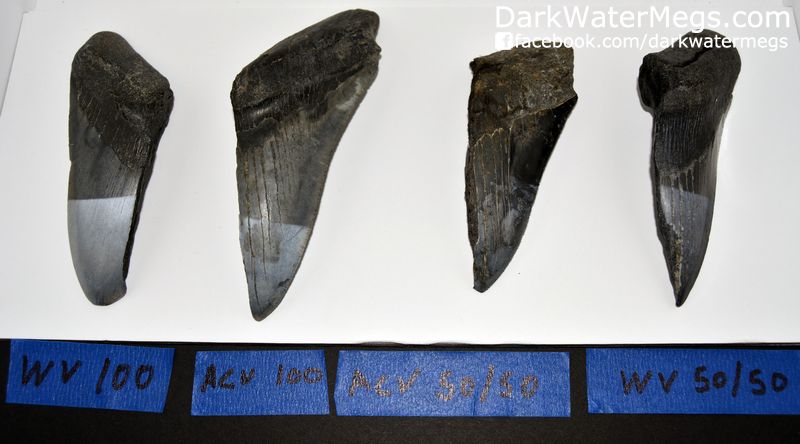

To try to repeat the process I took the teeth and put them back in water, once wet the bleached areas were not quite as obvious.
So the final verdict? Be careful when you clean your fossil megalodon teeth and other fossils. When I recover fossils from a new darkwater river, the ocean, or other site I always try to use a broken part of a tooth to experiment on first, that way if the tooth enamel scratches easily, crumbles if dried to quickly, etc. I will find out on a broken part of a tooth instead of a rare treasure.
I personally don't like to use vinegar or other acids to clean teeth, some people do and have varying levels of success doing it. I put this experiment and article together not to discredit anyone's methods but to warn people that simply dropping a tooth in an acid solution will not magically make it easier to clean without possibly severely bleaching or lightening the tooth. I have talked with many tooth hunters and collectors and it seems that most of them have a story about ruining a tooth with an acidic solution, a bad tool (future article to come), or other rushed cleaning process. If this article saves one nice ancient megalodon tooth from being bleached out it has done its job.
If you are looking for megalodon teeth for sale I have some on my web store Megalodon Shark Teeth For Sale (both cleaned and uncleaned).
* I feel like I should mention this test was not as complete and scientific as it could have been. For thoroughness I suppose I should have done 5-10% increments of vinegar to water, used a larger color variety of teeth, ran time samples from one minute to one month, etc. So for the scientists out there sorry for not doing this experiment justice, this test was just to try to highlight the risks of using vinegar and other acids to clean fossil sharks teeth.

 doing to their fossilized shark teeth when they leave them to soak in vinegar or other acids.
doing to their fossilized shark teeth when they leave them to soak in vinegar or other acids.











